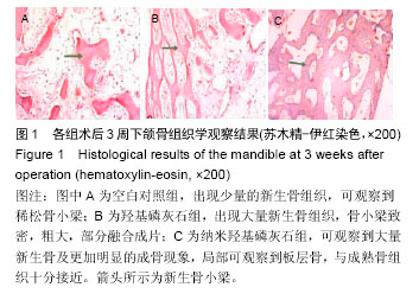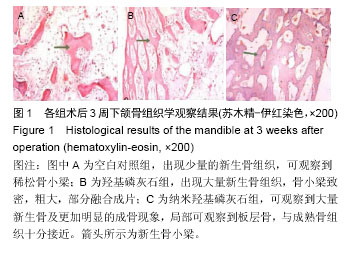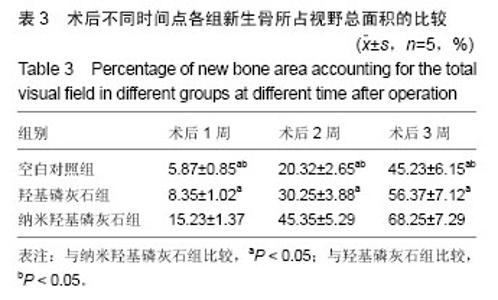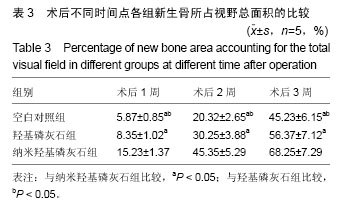| [1] 石铁,王泓杰,高秀秋,等.纳米羟基磷灰石及其复合材料对牙周膜细胞的影响[J].中国组织工程研究与临床康复, 2009,13(3):553-556.
[2] 王健平,周立波,岳红霞,等.氟纳米羟基磷灰石封闭人离体牙牙本质小管的生物相容性[J].中国组织工程研究, 2012, 16(16):2951-2954.
[3] 张艺君,尹路,张翼,等.掺钾纳米羟基磷灰石脱敏材料对ZPCC与牙本质粘结强度的影响[J].牙体牙髓牙周病学杂志,2015,25(10):596-601.
[4] 胡图强,何俐,李祖兵,等.纳米羟基磷灰石/PRP修复牙槽突裂的实验研究[J].口腔医学研究, 2008,24(3):262-265.
[5] 邱伟,时咏梅,徐进云,等.纳米羟基磷灰石直接盖髓诱导牙本质桥早期形成的可行性[J].中国组织工程研究与临床康复,2010,14(21):3869-3872.
[6] 叶眉,陈芳,姜大川,等.富血小板血浆和纳米羟基磷灰石胶原支架对人脂肪干细胞成骨分化的影响[J].口腔医学研究,2009,25(4):420-423.
[7] 鲁红,吴织芬,田宇,等.一种新型纳米羟基磷灰石材料应用于牙周组织工程的可行性研究[J].牙体牙髓牙周病学杂志, 2005,15(1):6-9.
[8] 赵熙儒,赵刚,莫宏兵,等,壳聚糖修饰后的纳米羟基磷灰石作为BMP-2输送载体转染细胞的研究[J].黑龙江医药科学, 2012,35(1):3-4.
[9] Hernandez ML,Alonso LM,Pradas MM,et al. Composites of Poly(methyl methacrylate) with Hybrid Fillers (Micro/Nanohydroxyapatite): Mechanical, Setting Properties, Bioactivity and Cytotoxicity In Vitro. Polym Compos.2013;34(11):1927-1937.
[10] 胡图强,何俐,喻学洲,等.纳米羟基磷灰石/混旋聚乳酸修复牙槽突裂的实验研究[J].郧阳医学院学报, 2008,27(4): 307-310,封2.
[11] 胡图强,何俐,李祖兵,等.纳米羟基磷灰石修复牙槽突裂的实验研究[J].临床口腔医学杂志,2007,23(5):288-290.
[12] 杨清岭,李宝花,尹蒙熔,等.纳米羟基磷灰石和纳米羟基磷灰石/聚酰胺66直接盖髓术的组织学对比观察[J].黑龙江医药科学,2010,33(3):27-28.
[13] 刘冰,陈鹏,臧晓霞,等.活性纳米羟基磷灰石复合胶原/聚乳酸材料对拔牙创早期愈合及牙槽嵴吸收影响的实验研究[J].口腔医学,2010,30(1):38-41.
[14] Liu L,Wang Y,Guo S,et al.Porous polycaprolactone/ nanohydroxyapatite tissue engineering scaffolds fabricated by combining NaCl and PEG as co-porogens: structure, property, and chondrocyte- scaffold interaction in vitro.J Biomed Mater Res B Appl Biomater. 2012;100(4):956-966.
[15] 刘泉,黄文.拔牙后牙槽窝即刻植入纳米羟基磷灰石的临床观察[J].口腔医学研究,2007,23(5):560-562.
[16] 韩纪梅,李玉宝,梁新杰,等.纳米羟基磷灰石与牙无机质的比较研究[J].功能材料,2005,36(7):1069-1071.
[17] 孙卫斌.纳米羟基磷灰石诱导人牙周膜细胞骨化分化的研究[D].四川大学,2005.
[18] Sharifi S,Kamali M,Mohtaram NK,et al.Preparation, mechanical properties, and in vitro biocompatibility of novel nanocomposites based on polyhexamethylene carbonate fumarate and nanohydroxyapatite.Polym Adv Technol.2011;22(5):605-611.
[19] Qiao Z,Perestrelo R,Shi X,et al.An exploratory study to evaluate the potential of nanohydroxyapatite as a powerful sorbent for efficient extraction of volatile organic metabolites, potential biomarkers of cancer. Anal Methods.2014;6(15):6051-6057.
[20] 孙庆顺,孟祥才,梁楠,等.纳米羟基磷灰石修复牙槽骨缺损的动物实验研究[J].黑龙江医药科学,2003,26(3):6-7.
[21] 韦纪英,何霞,贺于奇,等.PRP复合纳米羟基磷灰石对兔牙槽骨缺损的修复作用[J].广东医学, 2009,30(12):1786-1788.
[22] 王云,王青山.牙体修复性纳米羟基磷灰石复合材料的机械性能研究[J].现代口腔医学杂志,2011,25(2):115-117.
[23] 方厂云,曹莹,夏宇,等.大鼠牙乳头细胞与纳米羟基磷灰石的体外复合培养[J].中南大学学报(医学版), 2007,32 (1):114-118.
[24] Li M,Liu W,Sun J,et al.Culturing primary human osteoblasts on electrospun poly(lactic-co-glycolic acid) and poly(lactic-co-glycolic acid)/nanohydroxyapatite scaffolds for bone tissue engineering.ACS Appl Mater Interfaces. 2013;5(13):5921-5926.
[25] Lin BN,Whu SW,Chen CH,et al.Bone marrow mesenchymal stem cells, platelet-rich plasma and nanohydroxyapatite-type I collagen beads were integral parts of biomimetic bone substitutes for bone regeneration.J Tissue Eng Regen Med. 2013;7(11): 841-854.
[26] 邢晓艳,张青松.纳米羟基磷灰石在口腔医学中的应用[J].继续医学教育,2013,27(10):54-55.
[27] 郑谦,周立伟,魏世成等.纳米羟基磷灰石/聚酰胺(n-HA/ PA66)凝胶重建牙槽嵴的动物实验研究[J].中华老年口腔医学杂志,2003,1(3):137-139.
[28] Remya KR,Joseph J,Mani S,et al.Nanohydroxyapatite incorporated electrospun polycaprolactone/ polycaprolactone-polyethyleneglycol-polycaprolactone blend scaffold for bone tissue engineering applications.J Biomed Nanotechnol. 2013;9(9):1483-1494.
[29] 鲁红,吴织芬,田宇,等.应用生长因子-支架构建方式的组织工程方法再生牙周组织的实验研究[J].牙体牙髓牙周病学杂志,2005,15(1):10-13.
[30] Grenho L,Manso MC,Monteiro FJ,et al.Adhesion of Staphylococcus aureus, Staphylococcus epidermidis, and Pseudomonas aeruginosa onto nanohydroxyapatite as a bone regeneration material.J Biomed Mater Res A.2012; 100A(7):1823-1830.
[31] 孔祥盼.纳米羟基磷灰石修复即刻种植牙骨缺损的实验研究[D].佳木斯大学,2007.
[32] 鲁红,吴织芬,田宇,等.异体脱矿松质骨基质和纳米羟基磷灰石材料应用于牙周组织工程中的可行性探讨[J].中国临床康复,2002,6(17):2538-2539.
[33] Wu DJ,Liu SL,Hao AH,et al.Enhanced repair of segmental bone defects of rats with hVEGF-165 gene-modified endothelial progenitor cells seeded in nanohydroxyapatite/collagen/poly(L-lactic acid) scaffolds.J Bioact Compat Pol.2012;27(3):227-243.
[34] Qian X,Yuan F,Zhimin Z,et al.Dynamic perfusion bioreactor system for 3D culture of rat bone marrow mesenchymal stem cells on nanohydroxyapatite/ polyamide 66 scaffold in vitro.J Biomed Mater Res B Appl Biomater. 2013;101(6):893-901.
[35] 孙卫斌,吴亚菲,丁一,等.纳米羟基磷灰石诱导人牙周膜细胞碱性磷酸酶表达的研究[J].中华口腔医学杂志, 2006, 41(6):348-349.
[36] Jaiswal AK,Chandra V,Bhonde RR,et al.Mineralization of nanohydroxyapatite on electrospun poly(L-lactic acid)/gelatin by an alternate soaking process: A biomimetic scaffold for bone regeneration.J Bioact Compat Pol.2012;27(4):356-374.
[37] 赵刚,尹蒙熔,李德超,等.纳米羟基磷灰石修复牙槽骨缺损后正畸牙齿移动的可行性研究[J].黑龙江医药科学, 2010, 33(3):10-11.
[38] 闫永发,王春兰,范月静,等.纳米羟基磷灰石复合胶原植入术治疗牙周病骨缺损的疗效观察[J].中华临床医师杂志(电子版),2011,5(1):239-240. |







